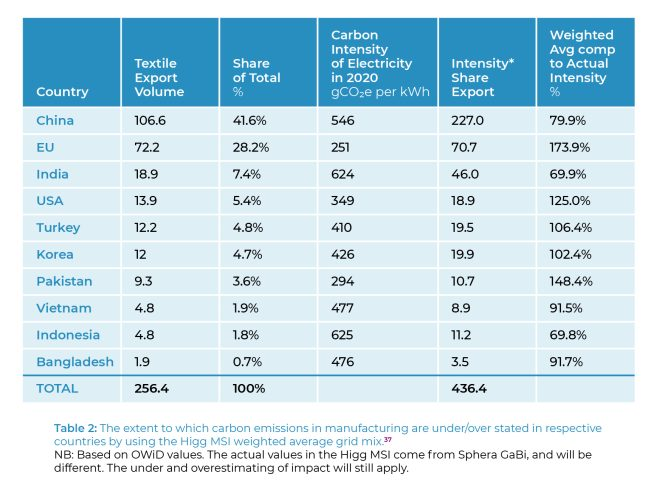Posted by Brett Mathews
GENEVA – Sustainability indices used by the fashion industry are giving a distorted impression of GHG emissions and progress towards 2030 and other carbon reduction targets. This is one conclusion of a new report which suggests the location of apparel production has up to eight times greater impact than fibre type on GHG emissions.
The location of apparel production and the ‘grid-mix’ in textile production countries has hitherto been ignored by the fashion industry as a way to track sustainability. Much focus instead has been on whether fibres are accredited to a certain scheme – eg BCI, organic – or recycled. This ‘red herring’, the paper argues, could be setting the industry up to miss key climate targets.
The report was published by the Geneva Center for Human Rights and authored by Veronica Bates Kassatly and Dorothee Baumann-Pauly.
It claims indices used by fashion to measure sustainability fall decidedly short in assessing true sustainability, and uses the The Business of Fashion (BoF) Sustainability Index.
The report suggests that data on GHG emissions from electricity and heat generation is available from several independent sources but the fashion industry is using this data in a way that understates emissions.

It claims current sustainability indices are weighted in such as way that, “fashion and apparel can become sustainable simply by switching fibres, and … the most important determinant of any shoe or garment’s sustainability is whether it was produced from ‘preferred’ or ‘certified’ material.”
The report points out that raw material or fibre production account for just 10 per cent of the apparel sector’s lifetime GHGs, and around 20 per cent of production emissions. Adds the report: “For climate change, the most important stage is manufacturing – representing roughly 60 per cent of lifetime GHGs and around 80 per cent of production emissions. Given the vast difference between countries in the carbon intensity of their energy systems, it is clear that the most important determinant of any item’s environmental impact at the factory gate or check out is where it was manufactured. The industry ignores this. So does the BoF Index.”
As such, the report argues that, “Brands must be obliged to declare the carbon intensity of their manufacturing based on the grid mix of the actual location – not some fictitious average which suggests that location and factory make no difference, and that the burden for climate change in fashion can be shifted onto farmers in the global south.”
Many fashion and textile businesses are now using various Higg Index tools to track sustainability progress. The report points out that with the exception of proprietary scores, the Higg MSI does not use its members’ primary data to calculate impacts for the manufacturing phase.
The Higg MSI thus effectively uses global averages for the grid-mix and does not provide an option to change the grid mix to reflect a lower or higher carbon intensive source, unless a manufacturer pays for a facility specific score to be added to the Higg system.
This means textile production in, say, Indonesia or China where GHG emissions are high is being classed as the same as production in Europe where emissions are much lower.,
The report also calls for ‘wears per garment produced’ to be used as as a truer measurement of sustainability. It adds: “Indices collect many indicators but fail to assess the most critical sustainability criteria, namely the average number of wears per garment produced. This is an extraordinary omission because when garments are used more frequently it reduces both the impact per wear and the volume of waste. Thus far, however, no attempts have been made to assess the quality and longevity of a brand’s products, or how they market to consumers, as part of their sustainability ranking.”


